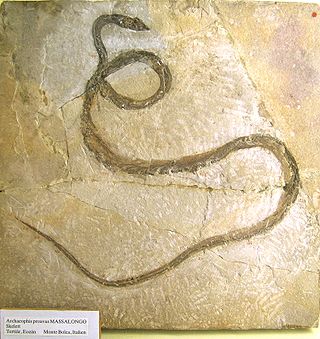
Monte Bolca is a lagerstätte near Verona, Italy that was one of the first fossil sites with high quality preservation known to Europeans, and is still an important source of fossils from the Eocene.

The billfish are a group of saltwater predatory fish characterised by prominent pointed bills (rostra), and by their large size; some are longer than 4 m (13 ft). Extant billfish include sailfish and marlin, which make up the family Istiophoridae; and swordfish, sole member of the family Xiphiidae. They are often apex predators which feed on a wide variety of smaller fish, crustaceans and cephalopods. These two families are sometimes classified as belonging to the order Istiophoriformes, a group which originated around 71 million years ago in the Late Cretaceous, with the two families diverging around 15 million years ago in the Late Miocene. However, they are also classified as being closely related to the mackerels and tuna within the suborder Scombroidei of the order Perciformes. However, the 5th edition of the Fishes of the World does recognise the Istiophoriformes as a valid order, albeit including the Sphyraenidae, the barracudas.
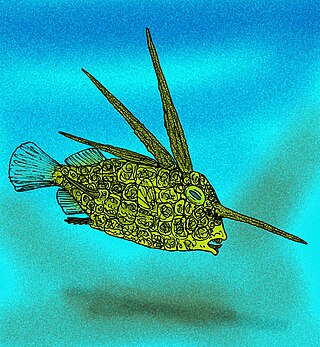
Eospinus daniltshenkoi is an extinct tetraodontid bony fish from the Eocene. Its fossils are from the Danata Formation lagerstatten of Ypresian Turkmenistan.

Bajaichthys is an extinct Ypresian zeid from the Monte Bolca Lagerstätten of Italy. It contains a single species, B. elegans, and is the only member of the family Bajaichthyidae.
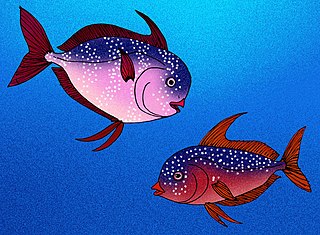
Turkmenidae is an extinct family of lamprids from the Paleogene of the west-central Asia, in what was formerly the Peri-Tethys Ocean. They were small, disk-shaped fish that bore a strong resemblance to their closest living relatives, the opahs.
Acestrus is an extinct genus of prehistoric marine ray-finned fish that lived during the lower Eocene in Europe. It contains one species, A. ornatus from the London Clay, known from a single braincase. It is thought to possibly be closely allied with billfish based on the braincase morphology, although it remains uncertain whether it had the rostrum characteristic of billfishes. Some authorities have suggested blochiid affinities.

Aeoliscoides is an extinct genus of prehistoric ray-finned fish that lived from the early Eocene. It is known from a single species, A. longirostris, from the famous Monte Bolca site of Italy. It was a member of Centriscidae, making it a relative of modern shrimpfish and snipefish. Its name references its close resemblance to the extant shrimpfish genus Aeoliscus.
Aulostomoides is an extinct genus of prehistoric marine ray-finned fish from the early Eocene. It contains a single species, A. tyleri from the Monte Bolca site of Italy. It is thought to be a member of Aulostomoidea, making it a relative of trumpetfish and cornetfish.
Aulorhamphus is an extinct genus of prehistoric marine ray-finned fish that lived from the early to middle Eocene. It contains four species known from the Early Eocene of Italy and the Middle Eocene of Russia. It was an aulorhamphid, an extinct family of syngnathiform fishes.
Anguilloides is an extinct genus of prehistoric marine eel that lived in the early Eocene. It contains a single species, A. branchiostegalis. Fossils are known from the famous Monte Bolca site of Italy.
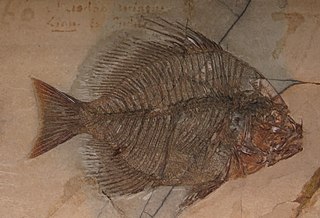
Archaephippus is an extinct genus of prehistoric spadefish that lived from the early Eocene. It contains a single species, A. asper, known from Italy. Several exquisitely preserved fossils have been found from the Monte Bolca lagerstatten. Some juvenile specimens preserve the vertical striped coloration that they would have likely had in life.
Aglyptorhynchus is an extinct genus of prehistoric marine billfish that was distributed worldwide from the early Eocene to the early Miocene. Fossils are primarily known from the Northern Hemisphere, but one species is also known to have inhabited the waters off New Zealand.
Cylindracanthus is an extinct genus of Cretaceous to Eocene aged ray-finned fish. It is almost exclusively known from bony rostrum fragments as well as some associated teeth, with the rest of the skeleton being cartilaginous. While originally considered to be closely related to billfish, the structure of its rostrum is dissimilar, and is unlikely to be closely related, some later studies suggested closer affinities to the Acipenseriformes. However, this was later rejected due to the lack of osteocytes in histologically examined specimens, which resembles the condition of derived teleosts. A close relation to Blochius has been suggested.
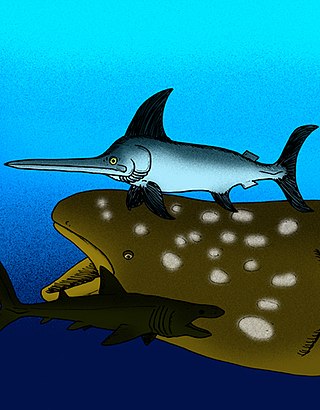
Xiphiorhynchus is an extinct genus of prehistoric swordfish that lived from the Eocene until the Oligocene. Unlike the modern swordfish, both the upper and lower jaws of Xiphiorhynchus were extended into blade-like points.

Palimphyes is an extinct genus of prehistoric euzaphlegid bony fish related to the escolars and snake mackerels. The various species lived as deepwater mesopelagic predators in the Tethys and Paratethys oceans, with fossils of ten species found in Paleocene to Oligocene strata of the Swiss Alps, the Carpathian and Caucasus Mountains, Iran, India, and Turkmenistan.
This list of fossil fish species is a list of taxa of fish that have been described during the year 2012. The list only includes taxa at the level of genus or species.
Giovanni Serafino Volta (1764–1842) was an Italian priest, naturalist, and palaeontologist, best known for his studies of fossil fish from Monte Bolca.

Istiophoriformes are an order of bony fish which is not fully recognized by some taxonomists, with some including the two extant families Xiphiidae and Istiophoridae, and others including the family Sphyraenidae.

Siphonostomites hesionoides is a species of polychaete annelid known only from subtidal lagoon deposits from the Early Eocene of Monte Bolca, Verona, Italy.













